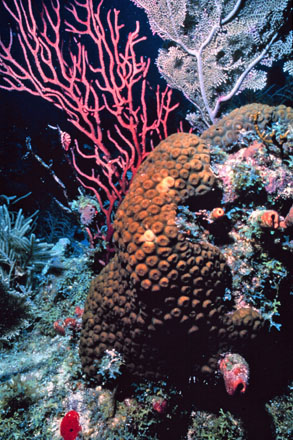Navigation
NOAA Helps National Coral Reef Institute Grow Coral in Laboratory for Transplantation to Damaged Reefs
Scientists at the National Coral Reef Institute (NCRI) are currently growing more than 400 corals from the larval stage as part of a National Oceanic and Atmospheric Administration (NOAA) -funded research, and will transplant them to restore damaged coral reefs.
|
Scientists at the National Coral Reef Institute (NCRI) are currently growing more than 400 corals from the larval stage as part of a National Oceanic and Atmospheric Administration (NOAA) -funded research, and will transplant them to restore damaged coral reefs.
Producing juvenile corals from the larval stage for transplantation is better for the health and longevity of coral reefs because it produces new coral, rather than moving around already existing fragments collected in the field. NCRI is also evaluating this technique to raise and restore populations of staghorn coral, a species recently listed by NOAA as threatened under the Endangered Species Act.
"NOAA strongly supports research that will help managers develop new tools to address coral restoration,” said retired Navy Vice Adm. Conrad C. Lautenbacher, Ph.D., under secretary of commerce for oceans and atmosphere and NOAA administrator. “In this Year of the Reef (IYOR), such innovative approaches may provide a new way forward to protecting these valuable resources.”
NCRI has successfully raised more than 100 juvenile mustard hill corals, Porites astreoides, and more than 300 great star corals, Montastraea cavernosa, both essential species for the development and growth of coral reefs.
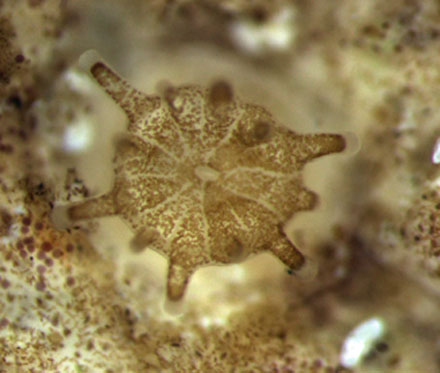 |
| M. cavernosa recruit at about 3 weeks old. Photo by National Coral Reef Institute |
According to Alison Moulding, PhD, NCRI Research Scientist, “P. astreoides is a brooding species which means that egg fertilization and larval development occur within the parent colony. Larvae are released from the coral and are competent to settle almost immediately. M. cavernosa is a broadcast spawning species. Eggs and sperm are released from the parent colonies during an annual spawning event, and thus fertilization and larval development occur in the water column.”
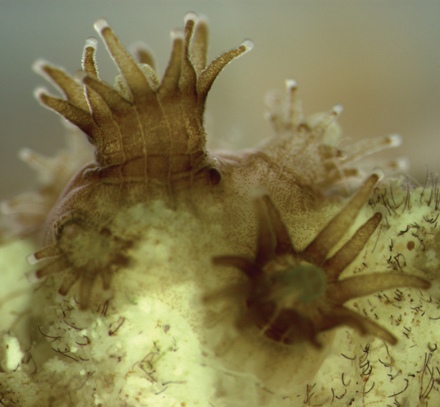 |
| Porites astreoides Photo by NCRI |
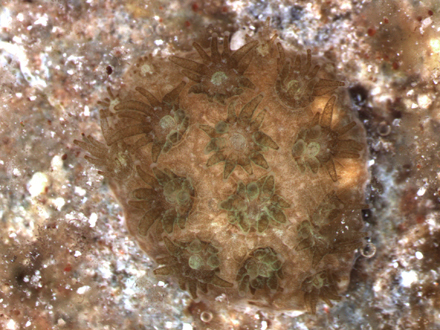 |
| Porites astreoides at eight months Photo by NCRI |
She said that they collected larvae from P. astreoides in May 2007. The larvae settled onto limestone tiles usually within a few hours to a day.
NCRI collected gametes from M. cavernosa colonies in September 2007and mixed the eggs and sperm for fertilization. Larval development took several days to about a week before the larvae were competent to settle.
The juvenile corals are being kept in indoor aquaria at the NCRI facility at the Nova Southeastern University Oceanographic Center near Ft. Lauderdale, Fla., and then are relocated to the outdoor coral husbandry system. If the corals successfully grow large enough in the outdoor system, they will be transplanted to damaged reefs.
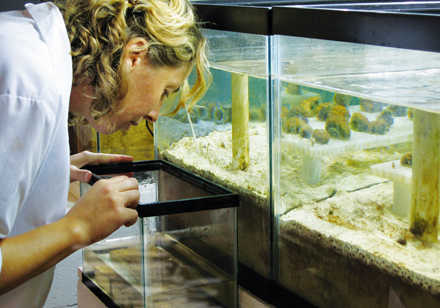 |
| Alison Moulding, PhD, NCRI Research Scientist observing corals Photo by NCRI |
No sites for transplantation have been selected. Moulding said, “I would like to target local reefs that have been injured due to ship groundings. Of course, permits will be required for this step, and we will work with local resource managers to find appropriate sites.”
So far the corals are surviving pretty well according to Moulding. She reports: “The P. astreoides corals have been growing and dividing and now form multi-polyp colonies. They are still all under a centimeter in size (most about 3-7 mm) after about 9 months in the lab. The M.cavernosa corals are still very tiny (most less than to about 1 mm) after 6 months in the lab. All of them are still single polyps and have not begun to divide. They have been growing, though, as some can now be seen without a microscope.”
“This is a long process since growth is so slow,” she added. “The corals likely will not be ready to be transplanted for several years. This project has been ongoing for less than a year, and we are still in the learning phase. We plan to collect larvae and gametes again in 2008 and hope to target more species in the future.”
“This work is consistent with NCRI’s mission of providing management related research output on assessment, monitoring, and especially restoration of coral reefs. We are proud to be working with NOAA on this important project,” said Dr. Richard Dodge, executive director of NCRI.
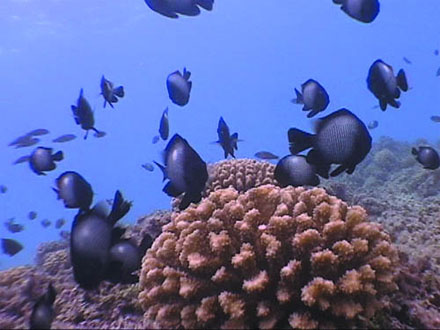 |
| Damsel fish and coral. Credit: NOAA |
Coral reefs, a critical part of the ocean ecosystem, teem with fish, lobsters, sponges, sea turtles, and thousands of other creatures that rely on them for their survival. Coral reefs also are important to the economy, providing millions of people around the globe with food, coastal storm protection, and jobs. Nearly a quarter of the world’s reefs are under imminent risk of collapse from human pressures, and a fifth have already effectively been destroyed and show no immediate prospects for recovery.
NOAA is funding this research to develop tools to help environmental managers address these issues.
The NOAA, an agency of the U.S. Commerce Department, is dedicated to enhancing economic security and national safety through the prediction and research of weather and climate-related events and information service delivery for transportation, and by providing environmental stewardship of our nation's coastal and marine resources. Through the emerging Global Earth Observation System of Systems (GEOSS), NOAA is working with its federal partners, more than 70 countries and the European Commission to develop a global monitoring network that is as integrated as the planet it observes, predicts and protects.
This article is from a report from NOAA of February 28, 2008 and from Horizon's correspondence with the National Coral Reef Institute.
NOAA/NOS is collaborating with Horizon International on its multimedia and multifaceted coral reef program Magic Porthole. The program Web page is: www.magicporthole.org.
Related articles on the Horizon Solutions Site www.solutions-site.org include:
· Coralpedia Established to Identify Corals, Soft Corals and Sponges of the Caribbean
· Kiribati Creates World’s Largest Marine Protected Area
· Coral Reef Playing Cards Capture Nationwide Audiences
· Coral Reef Playing Cards Launched In Advance of International Year of the Reef (IYOR)
· Possible Moonlight Trigger Found for Annual Mass Spawning of Corals
· Fishing Ban Protects Largest Coral Reef in The Philippines, Apo Reef
· New Security for Coral Reefs: Red and Pink Corals Get United Nations Trade Protection
· Horizon International Makes Its Television Programs On Solutions Available On The Web
· Magic Porthole Coral Reef Preview Offers Videos,Games, Resources
- Exhibits Coral Reefs
· Asian Tsunami Inflicts Multi-Million Dollar Damage on Indonesia’s Environment
· Announcement: Brave New Ocean Webcast March 3, 2006
· The Florida Keys National Marine Sanctuary management plan
· The Bonaire National Marine Park
Search
Latest articles
Agriculture
- World Water Week: Healthy ecosystems essential to human health: from coronavirus to malnutrition Online session Wednesday 24 August 17:00-18:20
- World Water Week: Healthy ecosystems essential to human health: from coronavirus to malnutrition Online session Wednesday 24 August 17:00-18:20
Air Pollution
- "Water and Sanitation-Related Diseases and the Changing Environment: Challenges, Interventions, and Preventive Measures" Volume 2 Is Now Available
- Global Innovation Exchange Co-Created by Horizon International, USAID, Bill and Melinda Gates Foundation and Others
Biodiversity
- It is time for international mobilization against climate change
- World Water Week: Healthy ecosystems essential to human health: from coronavirus to malnutrition Online session Wednesday 24 August 17:00-18:20
Desertification
- World Water Week: Healthy ecosystems essential to human health: from coronavirus to malnutrition Online session Wednesday 24 August 17:00-18:20
- UN Food Systems Summit Receives Over 1,200 Ideas to Help Meet Sustainable Development Goals
Endangered Species
- Mangrove Action Project Collaborates to Restore and Preserve Mangrove Ecosystems
- Coral Research in Palau offers a “Glimmer of Hope”
Energy
- Global Innovation Exchange Co-Created by Horizon International, USAID, Bill and Melinda Gates Foundation and Others
- Wildlife Preservation in Southeast Nova Scotia
Exhibits
- Global Innovation Exchange Co-Created by Horizon International, USAID, Bill and Melinda Gates Foundation and Others
- Coral Reefs
Forests
- NASA Satellites Reveal Major Shifts in Global Freshwater Updated June 2020
- Global Innovation Exchange Co-Created by Horizon International, USAID, Bill and Melinda Gates Foundation and Others
Global Climate Change
- It is time for international mobilization against climate change
- It is time for international mobilization against climate change
Global Health
- World Water Week: Healthy ecosystems essential to human health: from coronavirus to malnutrition Online session Wednesday 24 August 17:00-18:20
- More than 400 schoolgirls, family and teachers rescued from Afghanistan by small coalition
Industry
- "Water and Sanitation-Related Diseases and the Changing Environment: Challenges, Interventions, and Preventive Measures" Volume 2 Is Now Available
- Global Innovation Exchange Co-Created by Horizon International, USAID, Bill and Melinda Gates Foundation and Others
Natural Disaster Relief
- STOP ATTACKS ON HEALTH CARE IN UKRAINE
- Global Innovation Exchange Co-Created by Horizon International, USAID, Bill and Melinda Gates Foundation and Others
News and Special Reports
- World Water Week: Healthy ecosystems essential to human health: from coronavirus to malnutrition Online session Wednesday 24 August 17:00-18:20
- STOP ATTACKS ON HEALTH CARE IN UKRAINE
Oceans, Coral Reefs
- World Water Week: Healthy ecosystems essential to human health: from coronavirus to malnutrition Online session Wednesday 24 August 17:00-18:20
- Mangrove Action Project Collaborates to Restore and Preserve Mangrove Ecosystems
Pollution
- Zakaria Ouedraogo of Burkina Faso Produces Film “Nzoue Fiyen: Water Not Drinkable”
- "Water and Sanitation-Related Diseases and the Changing Environment: Challenges, Interventions, and Preventive Measures" Volume 2 Is Now Available
Population
- "Water and Sanitation-Related Diseases and the Changing Environment: Challenges, Interventions, and Preventive Measures" Volume 2 Is Now Available
- "Water and Sanitation-Related Diseases and the Changing Environment: Challenges, Interventions, and Preventive Measures" Volume 2 Is Now Available
Public Health
- Honouring the visionary behind India’s sanitation revolution
- Honouring the visionary behind India’s sanitation revolution
Rivers
- World Water Week: Healthy ecosystems essential to human health: from coronavirus to malnutrition Online session Wednesday 24 August 17:00-18:20
- Mangrove Action Project Collaborates to Restore and Preserve Mangrove Ecosystems
Sanitation
- Honouring the visionary behind India’s sanitation revolution
- Honouring the visionary behind India’s sanitation revolution
Toxic Chemicals
- "Water and Sanitation-Related Diseases and the Changing Environment: Challenges, Interventions, and Preventive Measures" Volume 2 Is Now Available
- Actions to Prevent Polluted Drinking Water in the United States
Transportation
- "Water and Sanitation-Related Diseases and the Changing Environment: Challenges, Interventions, and Preventive Measures" Volume 2 Is Now Available
- Urbanization Provides Opportunities for Transition to a Green Economy, Says New Report
Waste Management
- Honouring the visionary behind India’s sanitation revolution
- Honouring the visionary behind India’s sanitation revolution
Water
- Honouring the visionary behind India’s sanitation revolution
- Honouring the visionary behind India’s sanitation revolution
Water and Sanitation
- Honouring the visionary behind India’s sanitation revolution
- Honouring the visionary behind India’s sanitation revolution

